Whether musing about the greater understanding the Belle II particle physics experiment at KEK may bring to questions around Standard Model predictions, dark matter, and the asymmetry of matter and antimatter in the universe, or the exciting themes of parallel universes, the multiverse, and time travel that we see imaginatively explored in science fiction, physics remains an enduringly illuminating field of study for opening up one's mind to the unseen possibilities of the phenomenal world.
Within our own little realm of enthusiast audio, there's also illuminating 'time travel' listening adventures that we can engage in that will open up our minds to new possibilities in music and the recording arts from the acoustic (1877–1925), electrical (1925–1945), magnetic (1945–1975), and digital (1975 to present) eras of our historic recorded music canon.
As in physics, there are also 'paradoxes' that occur in enthusiast audio as we explore listening adventures in the different eras of our historic recorded music canon.
One such audio paradox is related to the sound quality of the recordings, versus the quality of the musical performances.
Over the last few decades, we audiophiles have tended to narrow our focus to the small subset of our historic recorded music canon that offers exceptional recording quality (typically albums from the magnetic era of recording).
Yet there's only a relatively small number of recordings that are marketed to audiophiles, and they tend to be reissued over and over again, which can get boring from a musical perspective.
"Oh yes, that umpteenth reissue of Miles Davis' Kind of Blue sounds great." Yawn.
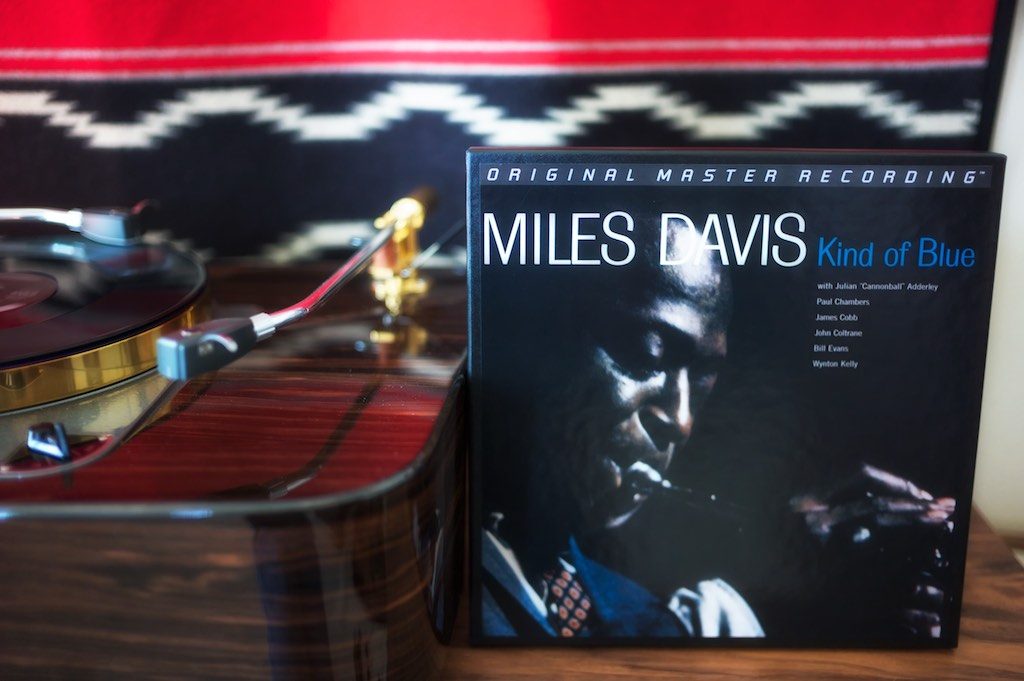
While there's certainly some great performances of music documented in some of the albums marketed to audiophiles, the reality is that most of the great musical performances recorded in history exist outside of that small subset of albums.
To get an idea of the implications for this paradox, try perusing recommended lists of albums based on the sound quality of recordings on audiophile-oriented websites, versus the music enthusiast websites whose focus is on the quality of the musical performances that were recorded.
There's not a lot of Venn overlap in those lists, are there?
If we focus only on the finest examples of recording quality, then we will miss opportunities to listen to many of the greatest musical performances that have been recorded since the advent of the recording arts in 1877.
A pertinent example of this paradox can be seen in Rob Cowan's article in Gramophone, 250 Greatest Recordings of All Time: Chosen by 35 of the World's Leading Musicians (HERE).
The focus of Rob's list of recordings is on the quality of the musical performances, as chosen by leading musicians, rather than on the recording quality of the albums per se, as we find with audiophile oriented reissues of albums.
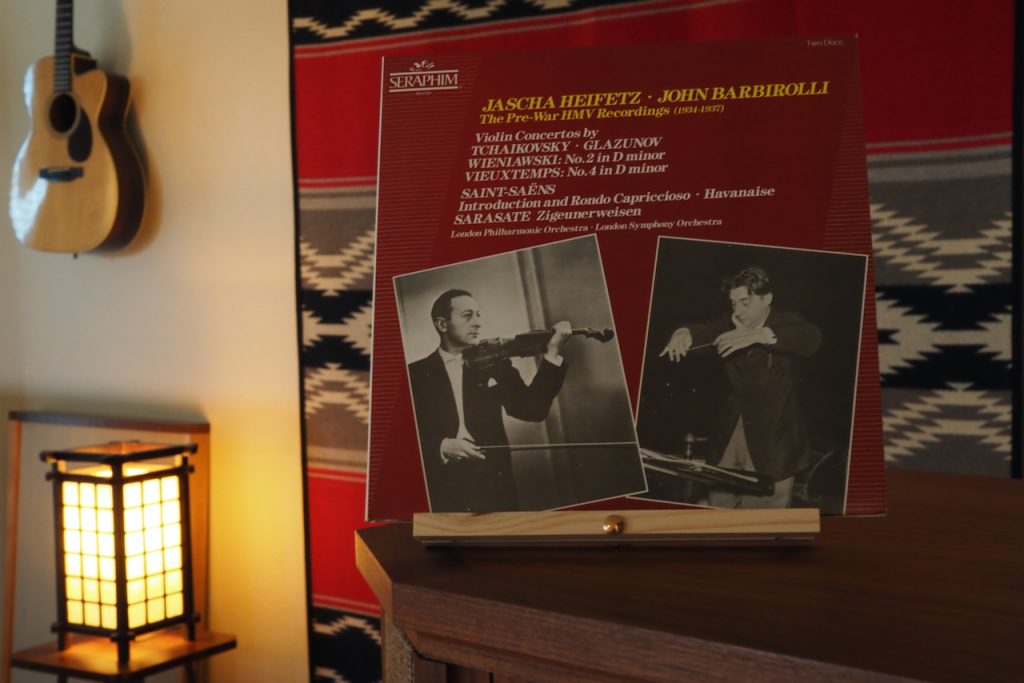
Heifetz-Barbirolli 'The Pre-War HMV Recordings of Saint-Saëns and Sarasate' - recorded 1935-1937 by EMI during the electric recording era.
The superb musical performances of Saint-Saëns and Sarasate by Heifetz-Barbirolli that violinist Hilary Hahn chose for Rob's article in Gramophone are a perfect example. Those performances were originally released on 78 records, which were recorded 1935-1937 by EMI during the electric recording era (1925 to 1945), and then were made available again in 1987 as the Heifetz-Barbirolli The Pre-War HMV Recordings 2 LP album set, due to their enduring importance as great performances.
The recording quality can actually be quite good from the early recording eras, although the recordings are typically noisier (but not always), and tend to have less recorded information above 6,000 Hz (but not always), than we find in the magnetic recording era, for example.
Many of those early performances were recorded direct-to-disc at 78 rpm, so you know there's a lot of good musical information stored in those grooves.
Interestingly, some of those early recordings have higher-fidelity within the bounds of their recording limitations of noise and frequency extension than do many recordings of later recording eras, which I suppose is a second sort of audio paradox.
A third audio paradox is that high-performance audio systems that have been optimized to maximize sound quality using only audiophile-style albums, often sound dreadful on the majority of albums from our historic recorded music canon.
Yet high-performance audio systems that are optimized to provide high-fidelity listening experiences from albums that span the entirety of our historic recorded music canon, tend to also provide amazing listening experiences from that small subset of audiophile-approved albums.
So if you listen to albums from the acoustic and electric eras of recording and you think they sound bad, its probably not those recordings that sound bad, but rather its more likely that its the way that your audio system is voiced that is at fault.
The upside is that if your system voicing is off, those early recordings can provide an opportunity to adjust the voicing of your audio system so that it is capable of providing high-fidelity listening experiences from all of the recording eras of our recorded music canon, which will open up new worlds of listening adventures for you.
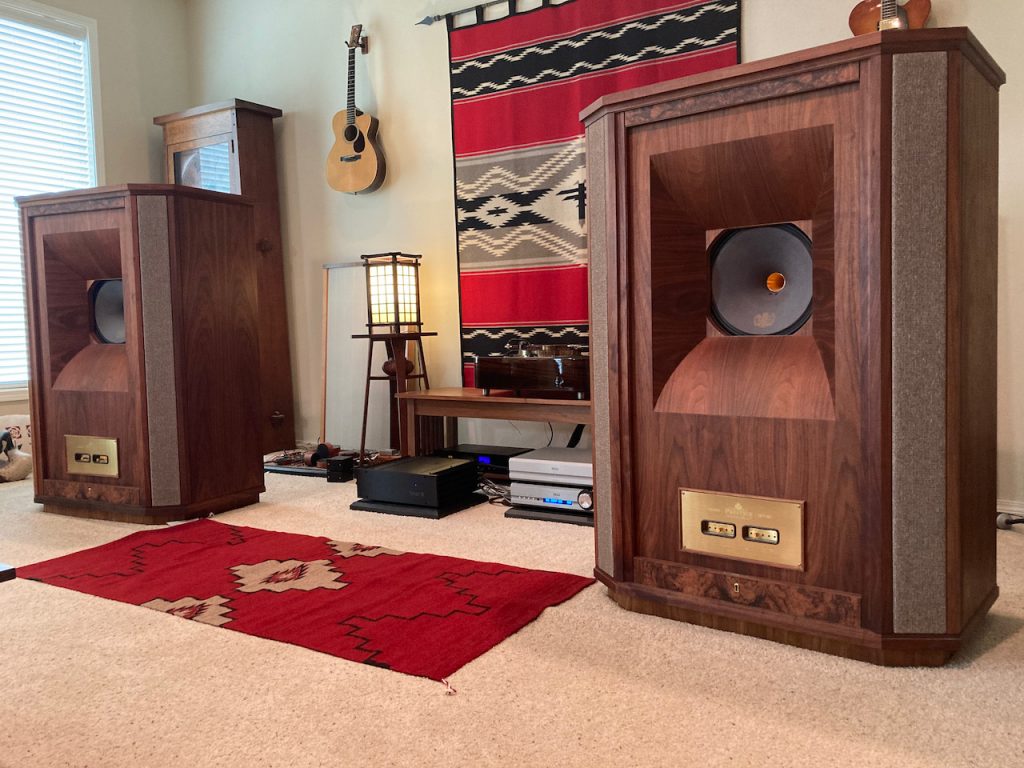
Speaking of system voicing, let me give you a recent example from my own audio adventures.
My Tannoy Westminster Royal SE loudspeakers have outboard Duelund CAST crossovers, with pure silver Duelund CAST components in their high-frequency circuits.
The combination of the Tannoy 15-inch coaxial drivers with silver components in the high-frequency crossover circuits can be astonishingly revealing of the performance of upstream components, but if you don't get the overall system tonal balance correct, they'll take your ears off.
I'm gearing up to write the Positive Feedback feature article about the new First Watt F8 stereo amplifier designed by Nelson Pass, so along with my Westminster loudspeakers, I've installed the First Watt F8 stereo amplifier, the Pass Labs XP-12 line-level preamplifier, and the Pass Labs XP-17 phono stage into my primary music system.
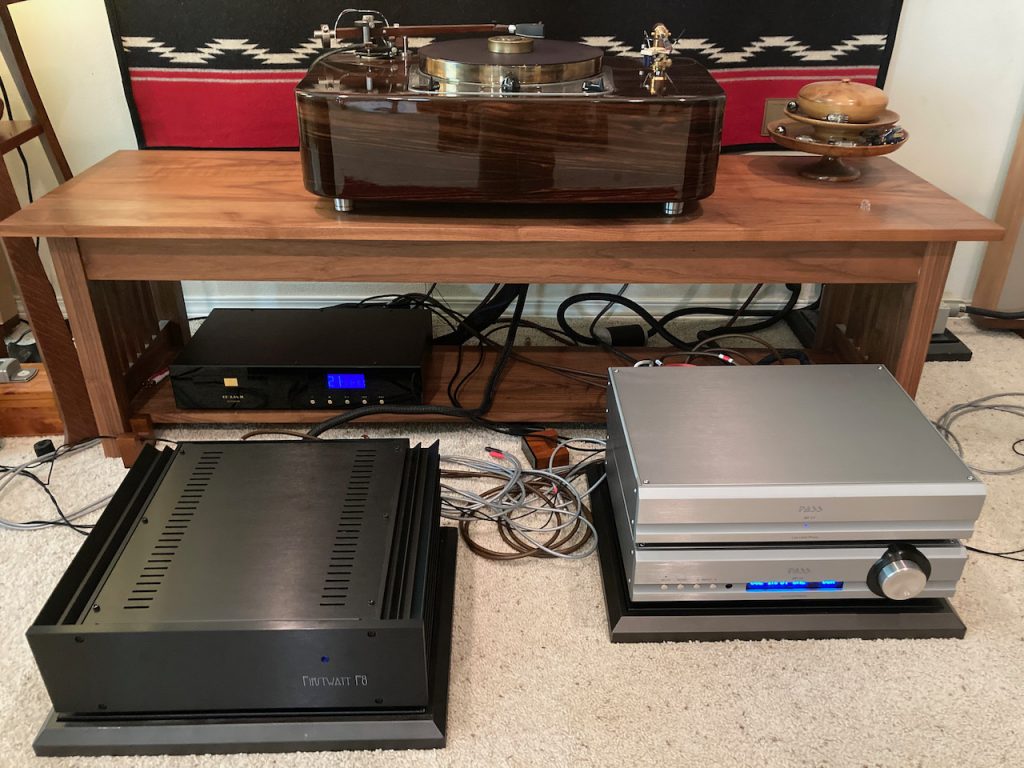
The digital and analog sources for the F8 article are the Audio Note (UK) CD 2.1x/II Red Book CD player, and the Audio Note (UK) Io I MC phono cartridge, both of which I hold in very high regard.
The First Watt F8 stereo amplifier, the Pass Labs XP-12 line-level preamplifier, and the Pass Labs XP-17 phono stage, replaced the Audio Note (UK) Oto Phono SE Signature integrated amplifier that I used in my most recent Audio Note (UK) review HERE.
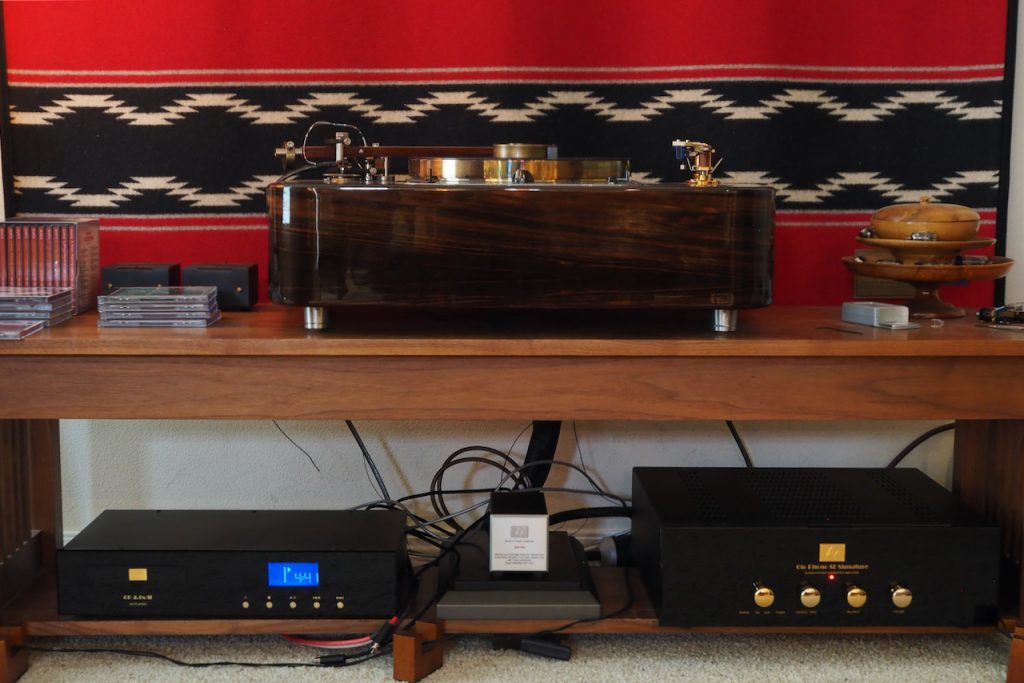
Audio Note (UK) system components.
The Audio Note (UK) silver interconnects and speaker cables that sounded complimentary with the Audio Note (UK) Oto Phono SE Signature integrated amplifier across a variety of recordings from different eras, sounded overly bright and forward in the presence region with the First Watt and Pass Labs amplification electronics.
Given that most high-performance audio equipment these days does't have the ability to adjust system equalization via tone controls, that meant I had to swap in and out various cabling to find a combination that provided a more balanced presentation across recordings from the different eras.
My jazz guitarist friend, David Gitlen, stopped by for our Thursday get-together, and we listened to some albums David brought along, while I swapped cables in and out.
A change of interconnects to the Duelund DCA16GA interconnects for the Audio Note (UK) CD 2.1x/II Red Book CD player; Belden 8402 microphone cable interconnects for the First Watt F8, the Pass Labs XP-12 line-level preamplifier, and the Pass Labs XP-17 phono stage; and a change of speaker cables to Duelund DCA16GA, brought the performance back into balance with the new electronics to provide a deliciously musical presentation across the recordings from the different eras.
David commented that he really liked what he was hearing from the First Watt and Pass Labs electronics. That final complement of cables mentioned above provided a smooth, liquid, and naturally live-like presentation of the music we were listening to that was just right, said he.
In this particular case, it turned out to be relatively easy to get performance dialed in for a balanced presentation across recordings from the different eras.
Depending on how you voiced your audio system, it might take a little cable and/or equipment juggling to achieve a balanced presentation across recordings from the different eras, but its well worth the effort to do so.
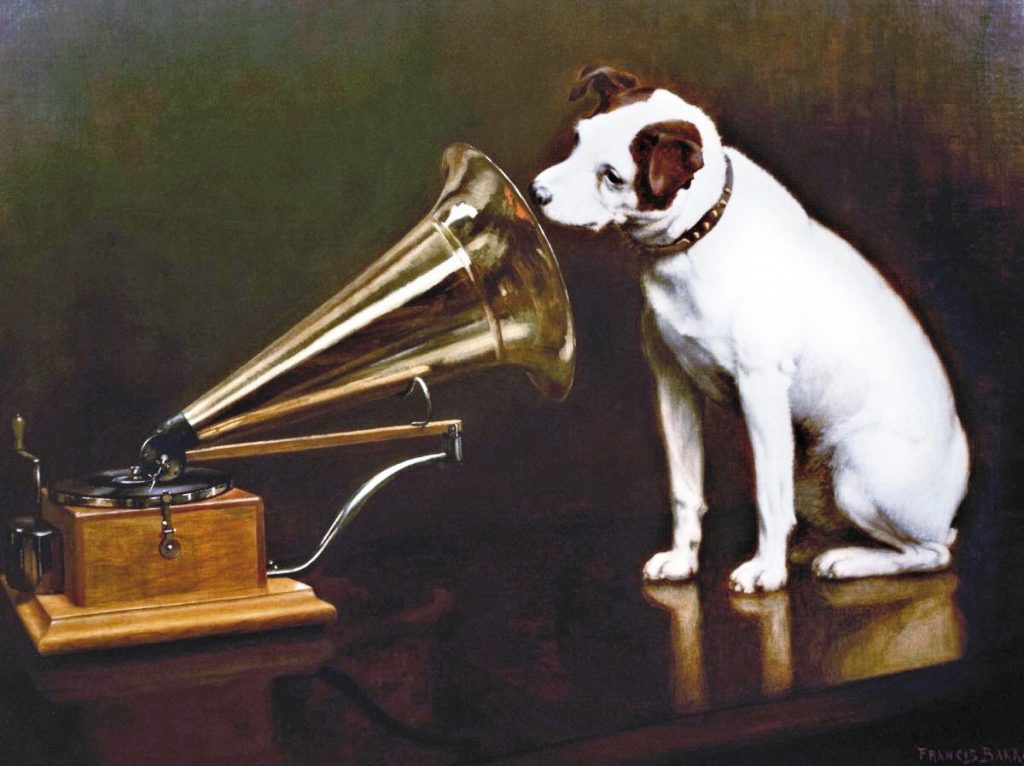
Public domain photo courtesy of Wikipedia.
Ok, with that little preamble out the way, let me tell you about some record labels that are passionate about preserving the greatest performances of music from our historic music canon for posterity, and who offer excellent transfers of musical performances from 78 records to CDs, making it possible for more listeners to enjoy those gems of musical performances from the past.
These record labels tend to offer a somewhat different take on what high-fidelity means for their 78 transfers to CD.
While all these labels feature important musical performances from the acoustic and electric eras of recording, some lean towards a more neutral 'modern' presentation, while others go for a more stylized 'vintage' presentation, but I recommend all of these labels for exploring the riches of musical performances that the early recording eras have to offer.
Audio Note (UK) Label

Peter's 78 transfers to CD-R.
Peter Qvortrup is in the process of getting his new record label setup so he can share with you his 78 records transfers to CD that were done by his late friend, recording engineer Anatoly Likhnitsky (1936-2013), in the former USSR.
The musical performances that Anatoly transferred from 78 records to CDs using his AML+ methodology and remastering equipment were from the acoustic and electric recording eras in the former Soviet Union, and are relatively unknown to most listeners in the West.
Anatoly's transfers were accomplished using custom electronics that accomplished equalization through transformers, similar in concept to the transformer RIAA equalization used in the Audio Note (UK) M9 phono preamplifier, and with vacuum tube amplification.
Sadly, after his passing, Anatoly's AML+ remastering equipment has gone missing, so there will be no more opportunities for AML+ 78 transfers to CDs.
Peter had provided funding to Anatoly to do 78 transfers to CDs, and Anatoly provided a selection of 78 transfers to Peter prior to his passing.
Peter sent me four CDRs of music that Anatoly transferred from 78s to CD. I have to say not only are they wonderful performances of music, but the sound quality that Anatoly achieved with his 78 transfers to CDs was truly remarkable.
The album I'll discuss in this post was from early in the history of the recording arts, Miron Poliakin Plays Glazunov, Tchaikovsky, Beethoven, Schubert, and Sarasate. The musical performances on this album were recorded 1938-1939 during the electrical recording era, when electrical microphones made their first appearance in the recording arts.
Anatoly's transfers were done without any noise reduction of the surface noise inherent in most old shellac records, as any removal of ticks and pops also removes musical nuance that can rob those ancient musical documents of life and vitality.
Having heard Anatoly's AML+ transfers with noise reduction, versus with no noise reduction, at Peter's home, I can tell you that the musical fidelity is rather dramatically reduced by incorporating noise reduction.
While listening to Anatoly's transfers, I felt like I was hearing an authentic portrayal of the essence of the musical performances on the Poliakin album, with beautiful violin tonality, lots of musical nuance, and a presence and immediacy of the performances that rivaled or exceeded what I hear from many recordings made during the magnetic era of recording (1945-1975).
While listening to the Poliakin album I also gained insights into how really good the recording quality could be during the electrical era of recording. I heard some surface noise from the old shellac 78s, but I really didn't find it to be a distraction from these incredible musical performances.
When these recordings become available from Peter's new record label, I highly recommend you get some of these rare recordings for yourself, as not only do they document superb musical performances, but they are also some of the most impressive transfers of 78 records to CDs that I have heard to date.
Marston Records
Marston Records in the USA is one of the most respected record labels worldwide for music lovers who love to listen to 78 record transfers to CDs.
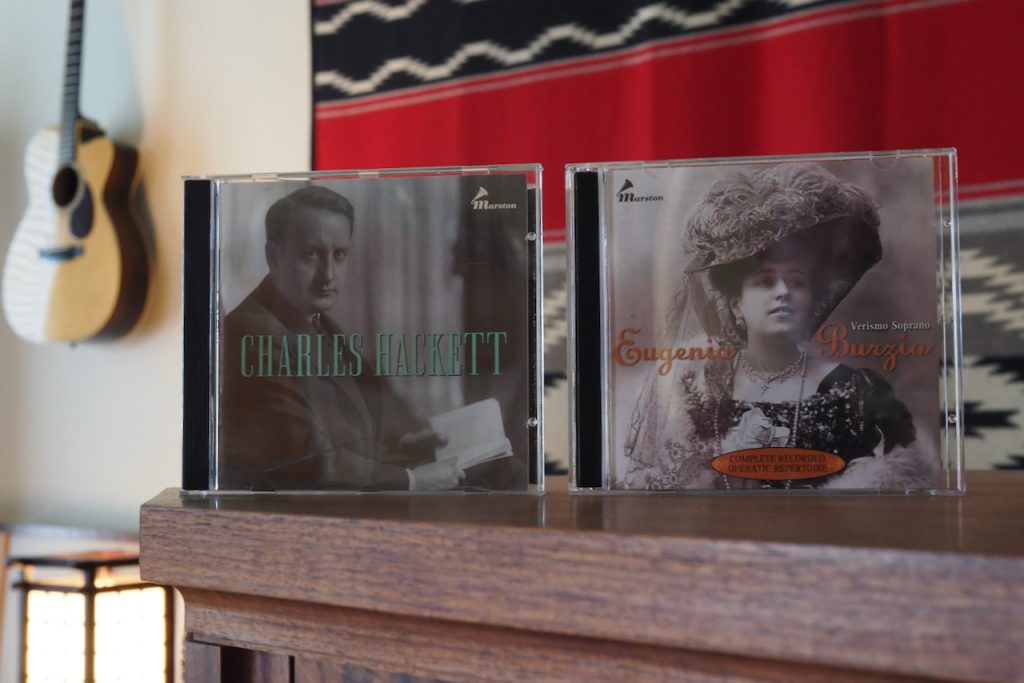
Marston Records 78 transfers to CD.
The Marston Records "About" section of their website says:
"Marston was founded in 1997 by Ward Marston and Scott Kessler. Today, Marston is known worldwide for its superlative sound, informative liner notes, and extensive booklets. The company has received outstanding reviews and awards. Its mission is to preserve the great performances of the past and keep alive the traditions that were prevalent at the dawn of recording."
I am so appreciative that Ward Marston and Scott Kessler are preserving these great performances from the early periods of the recording arts for the coming generations of music lovers.
I ordered a number of Marston Records CDs, and I'll be telling you about one of them in this post, a CD compilation of musical performances by Charles Hackett (photo above), who was "Gifted with a beautiful lyric tenor voice and a handsome stage appearance, Charles Francis Hackett was one of the first American tenors to establish a solid, international career."
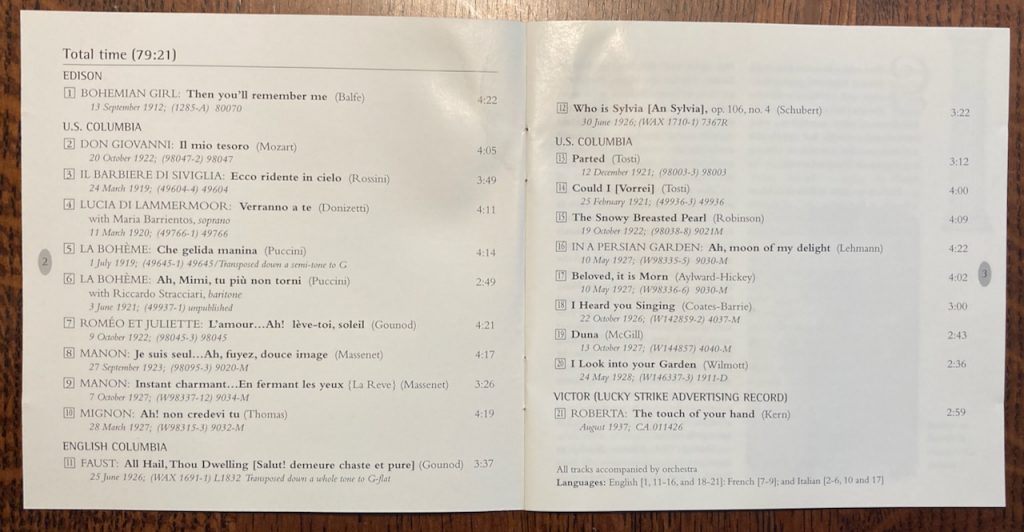
The recordings on this CD were sourced from Edison Records (1912), U.S. Columbia Records (1919 to 1928), English Columbia Records (1927), and Victor Records (1937).
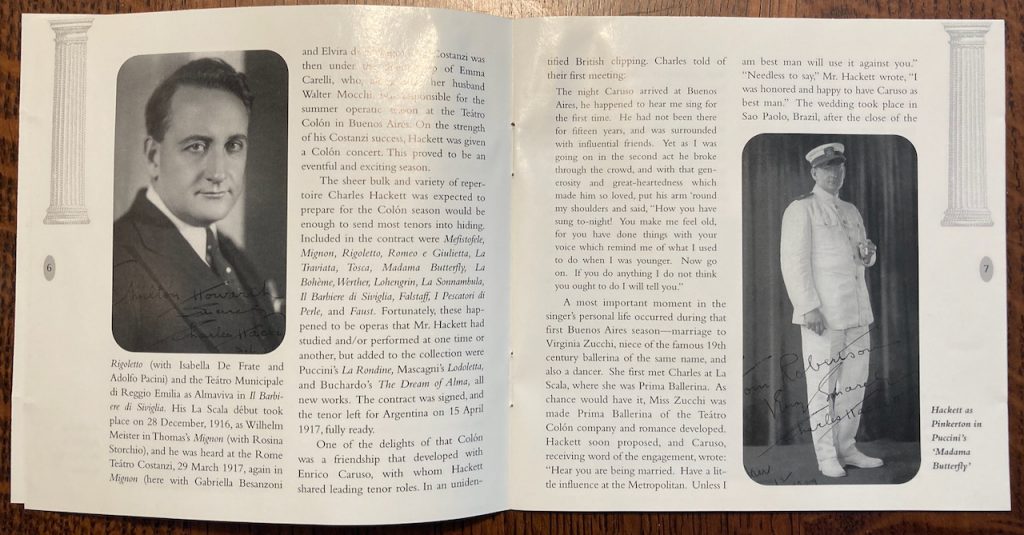
The booklet that comes with the CD is very informative and includes 13 pages of information.
The performances of Charles Hackett are superb, and while it was rather easy to hear the recording limitations of an early recording like "Bohemian Girl", transferred from an Edison record from 1912, the music transcends any recording limitations of the acoustic era of recording to provide a superb music listening experience.
The performance of "All Hail, Thou Dwelling" was sourced from an English Columbia record from 1926, and it is so quiet that you might have convinced me that it was a recording from the magnetic era, had I not known it was from a 78 record.
So not only do you get to hear historically important musical performances that are a lot of fun to listen to, but you also get to hear how the recording arts evolved over the period 0f 1912 to 1936 - spanning the acoustic and electric recording eras - which I find interesting in its own right.
Ward Marston is highly regarded for his transfers of 78 records to CDs, and listening to this compilation makes it easy to hear why.
On this Charles Hackett CD compilation, Ward combines tasteful selections of important historic performances, with transfers that preserves the musicality of the performances, maximizes their sound quality, and minimizes the effects of the recording limitations during the acoustic and electric recording eras to provide an eminently enjoyable listening experience.
Highly recommended.
Naxos Historical Music Label
The Naxos Historical Music Label is also a source of an abundance of great performances from the past, which you can also buy direct HERE, or order from other vendors such as Amazon.
From the Naxos Historical Music Label website:
"This label is devoted to keeping the great recordings of the past alive and accessible. Naxos uses the services of the finest transfer engineers, such as Mark Obert-Thorn and Ward Marston, to produce restorations of outstanding quality. There are separate series devoted to the greatest conductors, pianists, violinists, cellists and singers of the past."
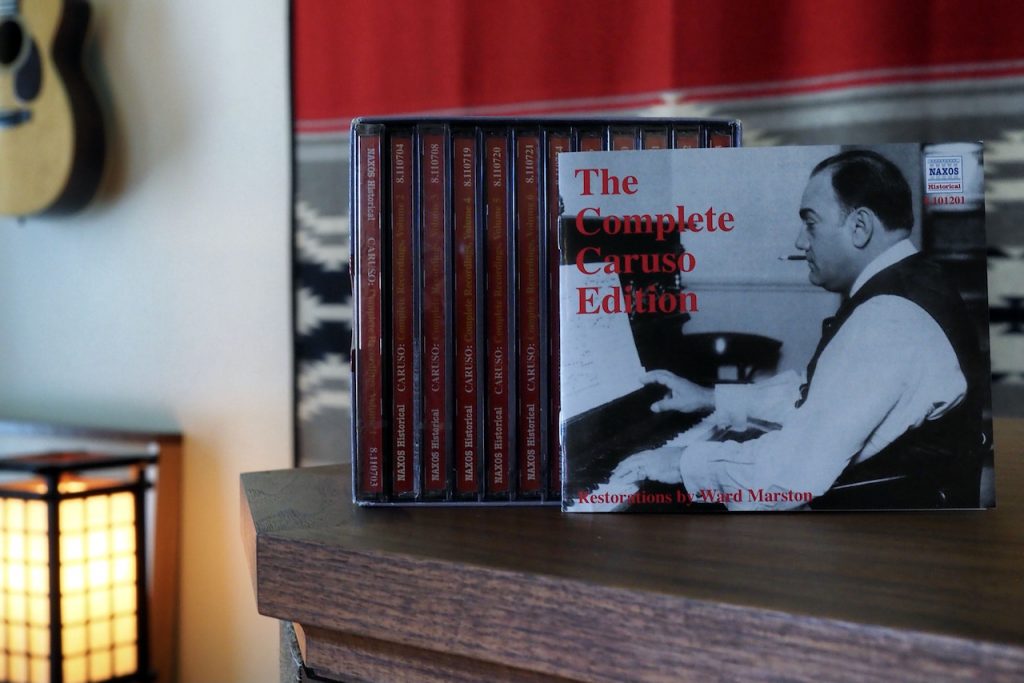
Naxos CD box set of the complete Caruso performances from the acoustic era of recording.
I ordered the Enrico Caruso: The Complete Recordings 12 CD box set (above), that consists of Caruso performances recorded from 1902 to 1920 during the acoustic era of recording.
Remember that I said Ward Marston's skills are highly regarded? Naxos hired Ward Marston to do this box set's transfers from 78 records.
Here's what it says about Ward Marston in the liner notes:
"In 1997 Ward Marston was nominated for the Best Historical Album Grammy Award for his production work on BMG's Fritz Kreisler collection. According to the Chicago Tribune, Martson's name is 'synonymous with tender loving care to collectors of historical CDs'. Opera News calls his work 'revelatory', and Fanfare deems him 'miraculous'. In 1996 Ward Marston received the Gramophone award for Historical Vocal Recording of the Year, honoring his production and engineering work on Romophone's complete recordings of Lucrezia Boria. He also served as re-recording engineer for the Franklin Mint's Arturo Toscanini issue and BMG's Sergey Rachmaninov recordings, both winners of the Best Historical Album Grammy."
"Born blind in 1952, Ward Marston has amassed tens of thousands of opera classical records over the past four decades. Following a stint in radio while a student at Williams College, he became well-known as a reissue producer in 1979, when he restored the earliest known stereo recording made by the Bell Telephone Laboratories in 1932."
"In the past, Ward Marston has produced records for a number of major and specialist record companies. Now he brings his distinctive sonic vision to bear on works released on the Naxos Historical label. Ultimately his goal is to make the music he remasters sound as natural as possible and true to life by 'lifting the voices' of his old 78 pm recordings. His aim is to promote the importance of preserving old recordings and make available the works of great musicians who need to be heard."
You can see quite a number of 78 transfers done by Ward Marston HERE, on Discogs.

The Complete Caruso Edition includes a master index booklet for all of Caruso's recorded performances in the box set.
I'm just getting started listening to this impressive box set, but I randomly picked out "Enrico Caruso Complete Recordings Volume 9" to tell you about in this post, which features recordings of Caruso during the period of 1914-1916.
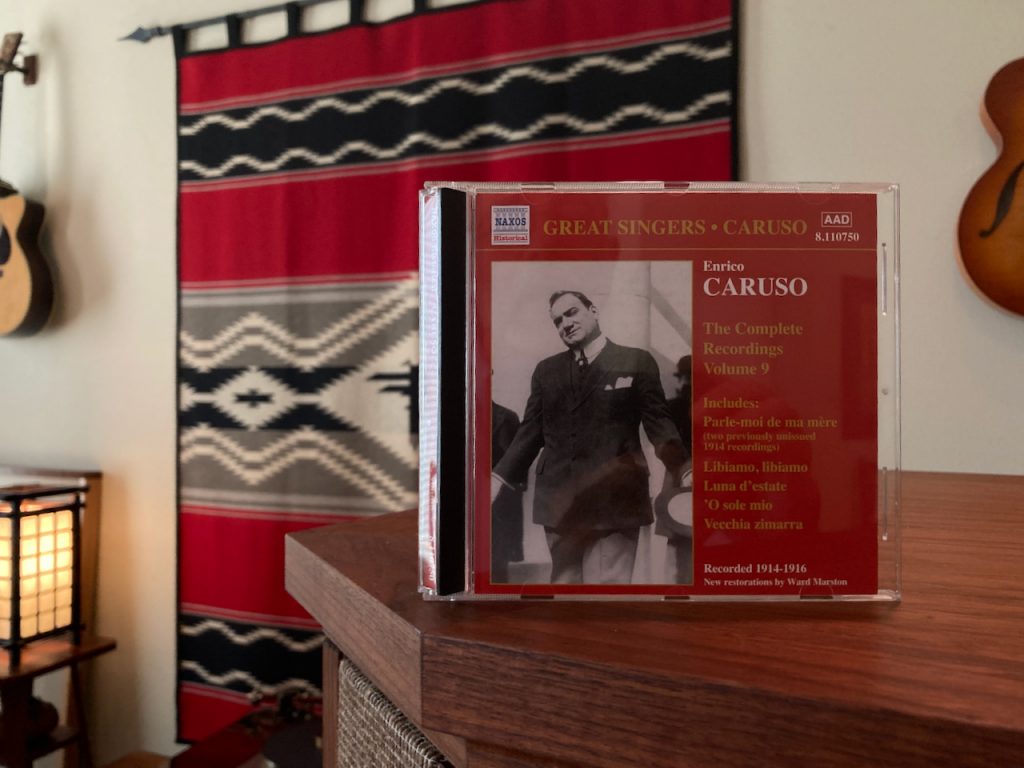
Each volume of the Caruso box set has its own set of liner notes that lists the details about each performance included.

Each volume also includes a nice essay about what was happening Caruso's life at the time of the recordings, with insights about his performances, as well as insights into the recording process during that period.

The sound quality is very good. There's the normal non-intrusive noise from the 78s, but the music rises above it, with full musicality and sound quality intact, to deliver imminently enjoyable listening sessions.
Highly recommended.
Nimbus Records 'Hermes' Label
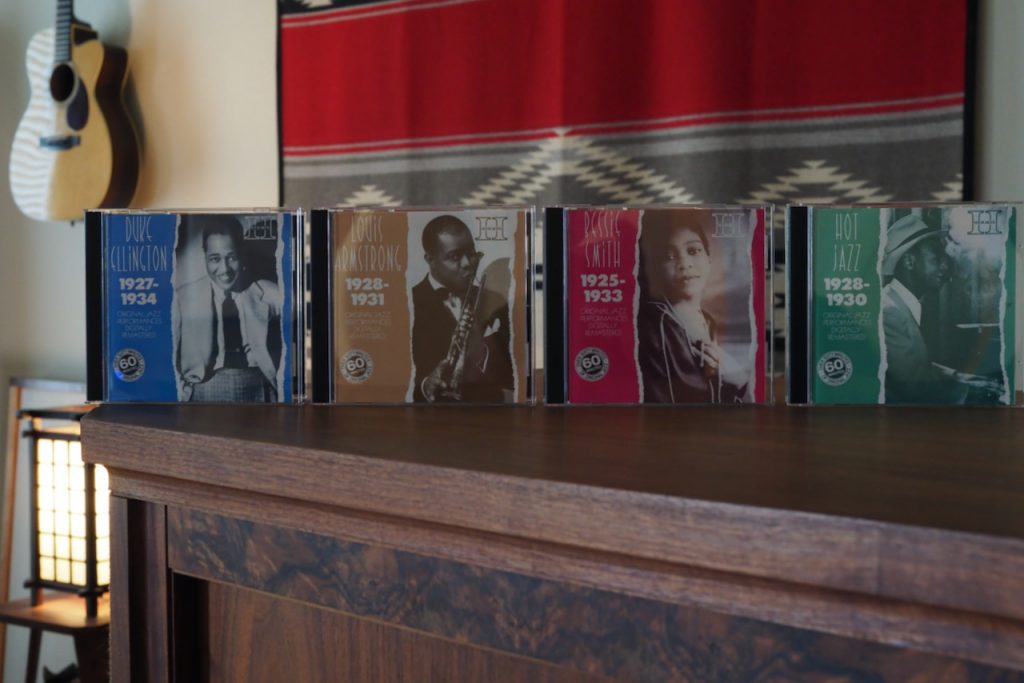
Nimbus Records Hermes 'Vintage Jazz Series' transfers from vinylite test pressings.
You might get the idea that there's only opera and classical music on 78 records, but that's not the case, as there's also important jazz performances from Duke Ellington, Louis Armstrong, Bessie Smith, and others, whom you can hear on the Nimbus Records Hermes label's 'Vintage Jazz Series'.
On the CDs back covers it says, "These transfers have been made from vinylite test pressings, as opposed to commercial shellac pressings, thereby giving true fidelity with minimal surface noise, without the use of artificial filtering or enhancement."
As I've experienced from Analogue Productions test pressings from the magnetic era of recording, test pressings can be very special indeed, and indeed these vinylite test pressings are too.
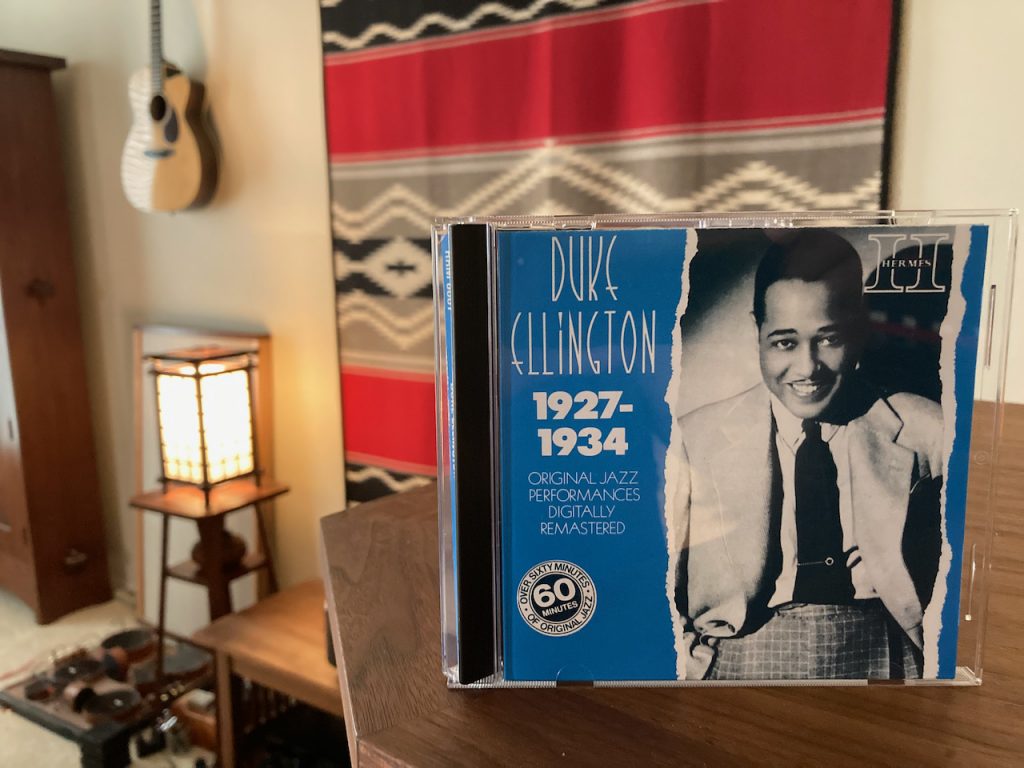
I'm listening to Duke Ellington as I write this, and the first thing I noticed was that these transfers from electric era vinylite test pressings are nearly as quiet as magnetic era recordings.
The sound is rich with timbral textures, vivid images, and dynamism, to give a very exciting and emotionally charged presentation.
One doesn't normally think of audiophile 'soundstaging' when talking about electric era mono recordings, but this recording is notable in that regard.
The soundstage is limited to the width between the loudspeakers, but the depth and imaging dimensions are impressive.
The way the musicians were placed for the recording is clearly evident, with their images arrayed in specific locations, and notably distinct layering of the images back into the depth dimension of soundstage, which also happens to have a nice big sense of ambient space.
From an audiophile perspective, the vividness of the images, and the layering of images into the depths of the soundstage, are more prominent than you find on a lot of magnetic era recordings. I was a little surprised by that.
The combination of the superb sound quality along with the magnificent performances on Duke Ellington 1927-1934 pretty much rocked my world.
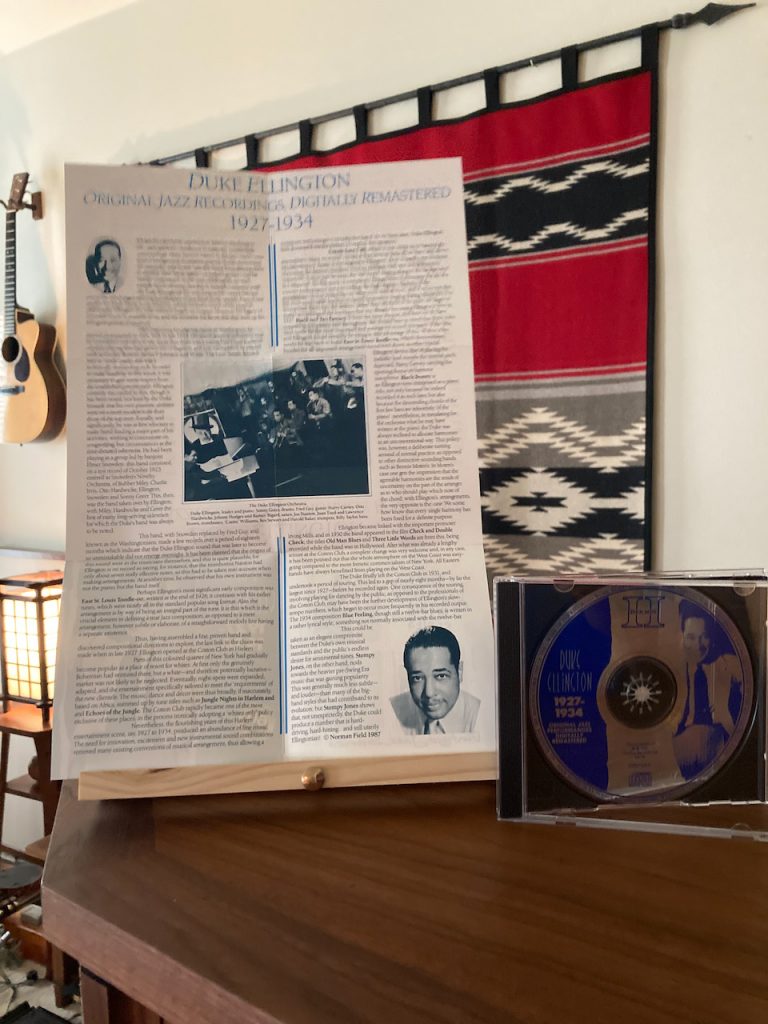
I almost forgot to say how much I enjoyed the foldout liner notes. I found it really nice to be able to hold the notes in my hands like a newspaper, read reasonable sized text, along with the absolutely fascinating essay written by Norman Field, about Duke, the orchestra, the Cotton Club, and the music.
I was intrigued by the following text in the liner notes:
"Even if one studies his book Music Is My Mistress, which includes much of his musical philosophy, Ellington the man remains largely an enigma. However, his legacy of recorded music is available to us, and the nineteen tracks on this disc sum up his first great period of creativity."
I just added Music Is My Mistress to my list of books to buy.
Duke Ellington 1927-1934 is way, way, recommended.
Nimbus Records 'Prima Voce' Label
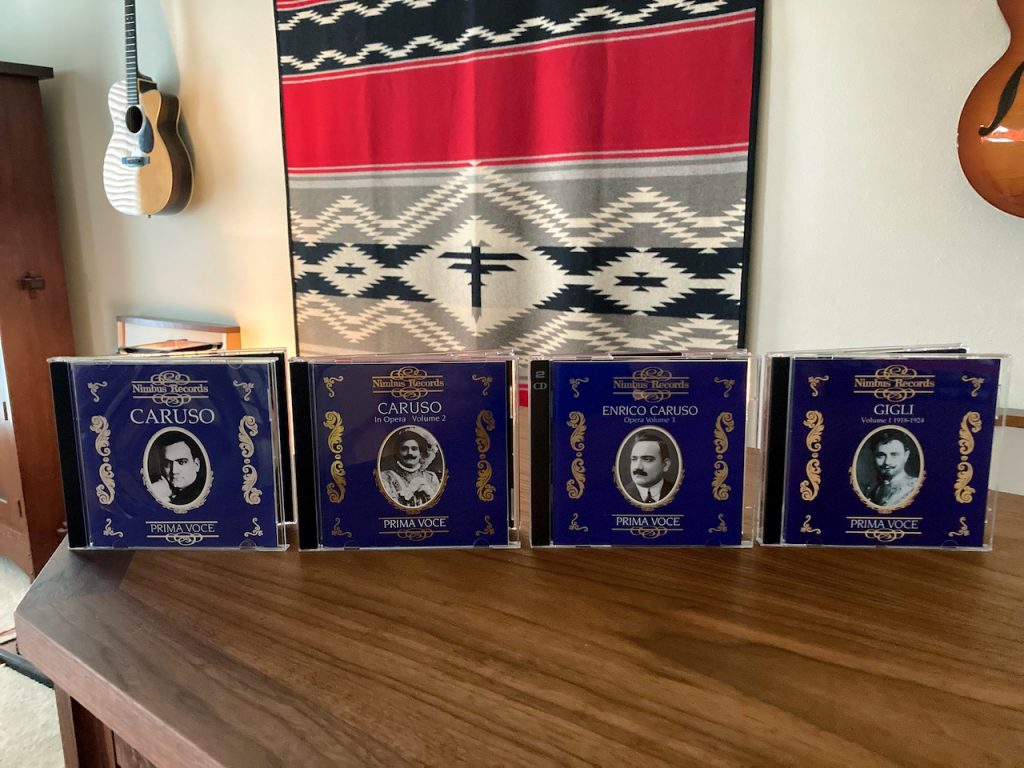
The Nimbus Records Prima Voce series represent a more stylized approach to transfers from 78 records to CDs, in that the 78 records are played back over a large custom horn and re-recorded, rather than transferred directly from the 78 records.
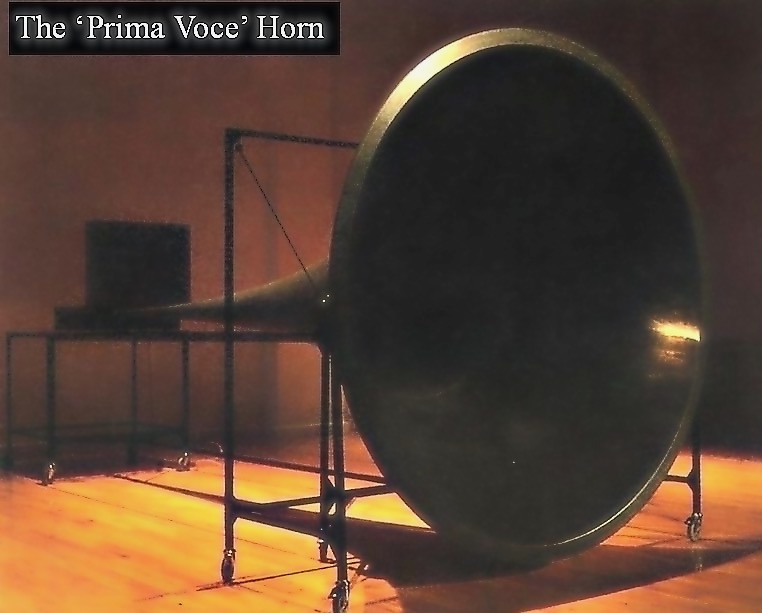
Photo courtesy of Nimbus Records.
In Nimbus Records own words:
"Unlike other companies who tend to use modern electric pick ups to transfer their records we prefer to play our 78s using an acoustic horn gramophone. In doing this we produce a warm, vibrant and extremely lifelike sound which requires very little processing (only the worst clicks are removed) before issue. In fact the only 'electric' part of the whole playback process is the Technics SL-15 turntable which is used to ensure that the record is running at the correct speed."
"Our purpose built horn gramophone is no more than a development of machines that existed in the 1930s. Not faced with the problem of fitting the apparatus into an average sized living room we have made it much longer (its length is nearly six metres) and changed the shape of the horn's curve. These adaptations enable extreme frequencies of the original recording to be heard more clearly and provide us with a more balanced sound. The thorns which we use are made of a pliable wood and will quickly shape themselves to the fit snugly into the groove of a 78. It is unlikely that a thorn will last much longer than one side of a record before the quality of the sound begins to deteriorate. Sections of the records we are transferring (usually the ends) are therefore often played more than once and the best of the different takes are matched and joined in the editing suite."
"In playing the records in the Performing Arts Centre of the Nimbus Foundation we are virtually allowing the artists a second chance to make their recordings, this time in a more generous acoustic. The conditions under which many of these artists recorded were often cramped and difficult and one often wonders what chance the voice really had!"
"The microphone which we use is exactly the same one that we use to make the majority of our ambisonic recordings. It is positioned so that it is central to the aperture of the horn and its distance from the horn is varied depending on the singer's voice and the quality of the records we are transferring. Changes of microphone position are kept to the bare minimum during a session unless the original recordings are radically different. No mixers, faders or processors are involved. A session in the Hall might last for anything up to a week during which we usually hope to transfer a minimum of two discs."
"Despite the application of thought and effort and the amount of time involved with each Prima Voce release, the basic principle remains very simple: we play the records the way they were intended to be played and record the results in much the same way that all our recordings are made."
For more information on the Nimbus Records Prima Voce approach to these transfers you can read more about it at the Wyastone Estate website HERE.
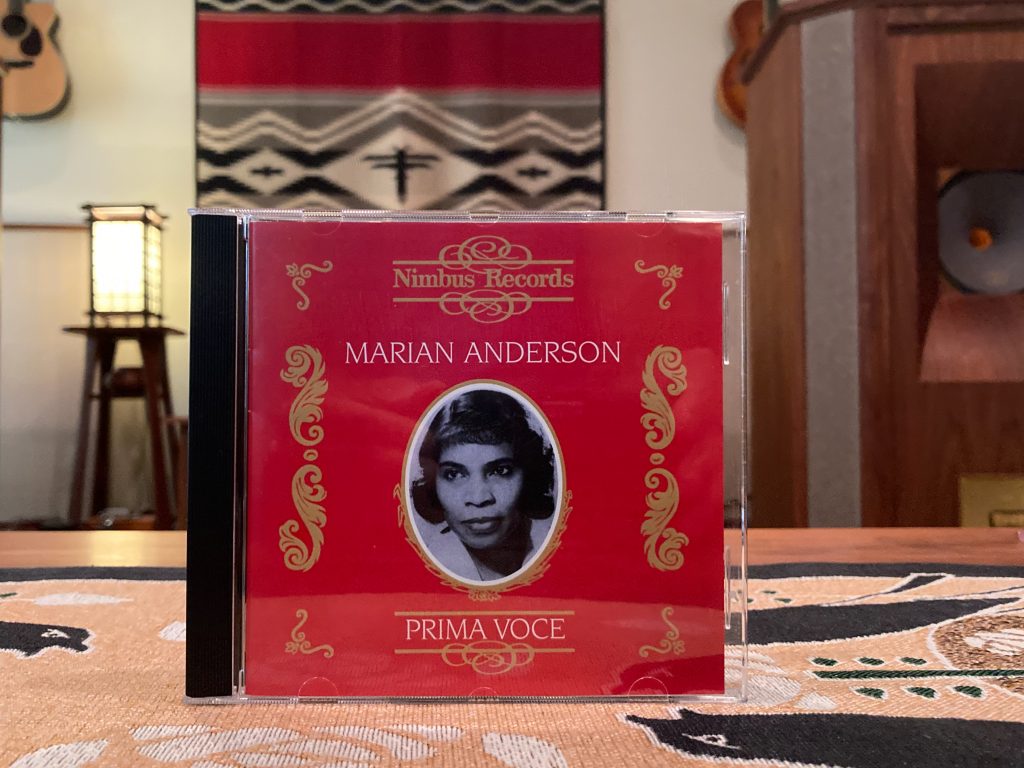
The Prima Voce approach to re-recording these 78 performances is unique, and the 'transfers' are enjoyable to listen to, with low noise levels, a warm and natural sounding presentation of the music, and with a touch of gramophone goodness to warm your heart.

I've really enjoyed listening to Nimbus Records Prima Voce CD of Marian Anderson performances, which includes liner notes with the details about the source 78 records (above), and an enjoyable essay about her life and career (below).

I'll bet it would be a lot of fun to hear the gigantic Nimbus Records gramophone playing 78 records, but at six meters in length it would be a tight fit in my living room!

I guess I'll have to settle for the next best listening experience, which is listening to the delightful Nimbus Records Prima Voce CDs on my hifi.
Highly recommended.
The Record Collector Label
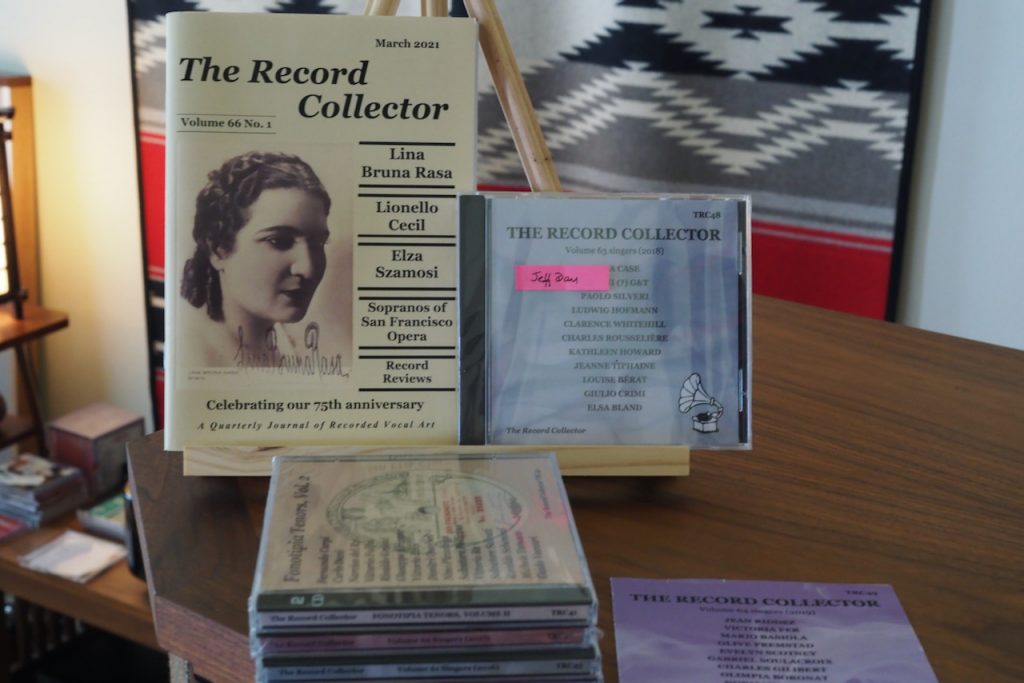
The Record Collector magazine and 78 transfers to CD.
The Record Collector magazine is an enjoyable and informative read, and has been in publication since 1946.
The Record Collector "... has become one of the most respected journals on historic singers of the 78 rpm era and their recordings. It is essential reading for record collectors, historians and those who love great singing."
The Record Collector also offers CDs for sale (HERE).
"Every year we issue a CD retrospective of the singers who were the subjects of articles in the previous volume. In this way our readers can hear these singers at their best in rare, beautiful and often previously unavailable material. Many of the items are being issued on CD for the first time and several are receiving their first-ever reissue."

The CDs come with brief liner notes that identify the 78 record sources for the transfers to CDs (below) ...

... and a brief discussion of individual signers featured on the CDs (below).
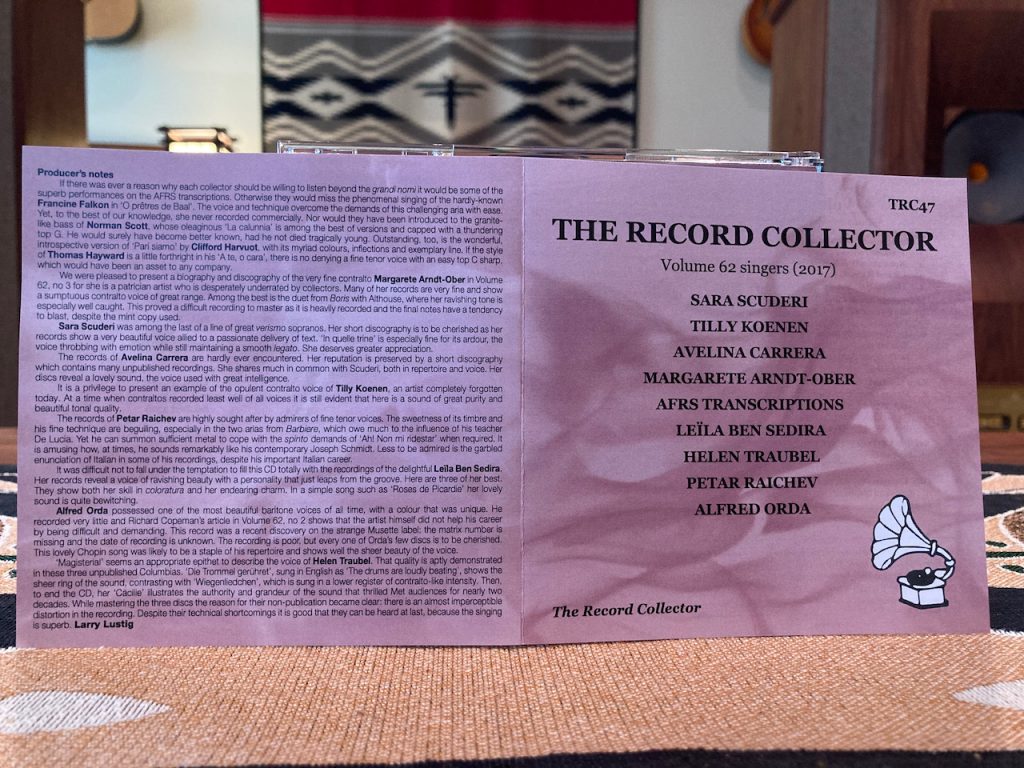
However, The Record Collector beats everyone offering 78 transfers to CDs for 'liner notes', in that you can read the in-depth discussions about each singer in the four issues of The Record Collector each year.
The 78 transfers to CDs are very well done, with superb choices of performances, with excellent musicality and sound quality, particularly considering their vintage sources.
I don't know who performed the 78 transfers to CD, as the website and liner notes don't say, but it may be Ward Marston, as there is a link to Ward's website on The Record Collector website.
Highly Recommended.
I am relatively new to listening to 78 record transfers to CDs, and the record labels offering them, but I having been greatly enjoying my listening experiences with these great performances of music from the acoustic (1877–1925) and electrical (1925–1945) recording eras.
I recommend these 78 record transfers to CDs to you as an excellent place to get started in expanding your musical horizons.
There's an intense immediacy and musicality that these 78 transfers to CDs of musical performances from "the greatest generation" of the past have, and in that regard they can rival and even surpass more modern recordings from the magnetic and digital eras.
While these 78 transfers to CDs represent a different sort of listening experience compared to contemporary recordings, they are extremely enjoyable to listen to on high-fidelity audio equipment.

I found my listening sessions to be engrossing and mesmerizing. I might not be able to do time travel from a physics standpoint, but as a musical experience I engage in immensely satisfying time travel every time I listen to these 78 transfers to CDs on my hifi systems.
Postscript: After writing this article I came across the website of Norbeck, Peters & Ford (HERE) who specialize in "... selecting and selling 78s, LPs, and finally CDs of historical interest, precisely because we believe in the quality and stylistic authenticity of historically important performances which are rarely equaled, hardly surpassed."

Norbeck, Peters & Ford are a treasure trove of important performances on 78s, LPs, CDs, DVDs, periodicals, pertinent website links, and more. Be sure to check them out!
As always, thanks for stopping by, and may the tone be with you!





























